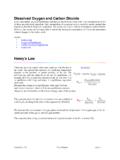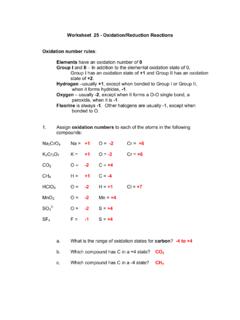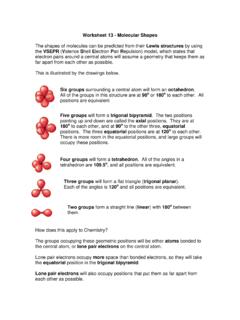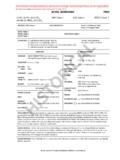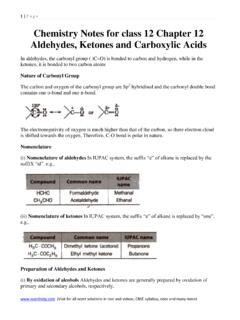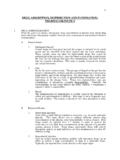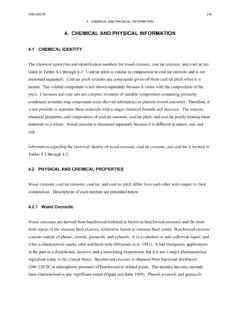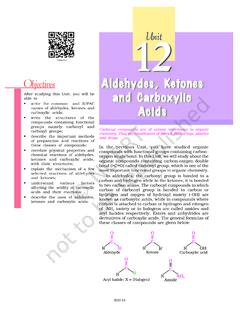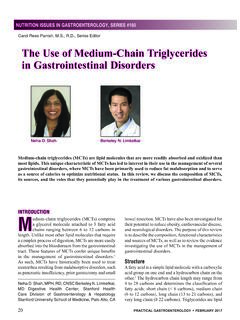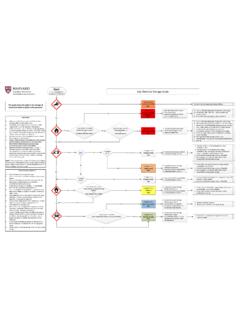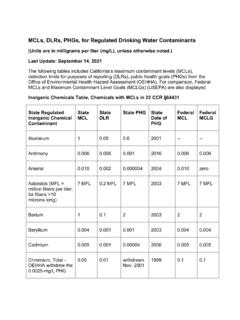Transcription of Reactions of Fats and Fatty Acids - University of Illinois ...
1 Reactions of Fats and Fatty AcidsOutline Fats and Oils Fatty acid Biosynthesis Biodiesel HomeworkWe hear quite a lot about the place of fats and oils in human nutrition. Foods high in fat are at the top of the food pyramid and these foods have about twice the energy content as carbohydrates. Too much fat in the diet can contribute to fats are not bad! Humans and other animals need fats and we can convert glucose and other carbohydrates into fats. Fatty Acids are precursors to the molecules that form cell membranes throughout our bodies and precursors to key signaling and Fatty AcidsFats and oilsPlants and animals use fats and oils for the long-term storage of starch fatFrom a chemical standpoint, fats and oils are the same.
2 They differ only in their melting points with oils being a liquid at room temperature. They are triesters, composed of 3 long chain carboxylic Acids and a triol (a molecule with 3 alcohol groups).The triol is made by the reduction of glyceraldehyde. Remember that 2 glyceraldehyde molecules come together to make glucose. The reaction is reversible and glyceraldehyde can be formed in the break down of glucose. NADPH (nature's H- source) adds to the carbonyl carbon and a proton adds to the carbonyl oxygen to make 104 Prof.
3 Shapley page 1 Each of the alcohol groups on glycerin can act as a nucleophile towards a carboxylic 104 Prof. Shapley page 2 Fatty acidsSome of the common Fatty Acids are listed in the table below. Some of these have alkyl chains that are completely saturated (no double bonds). Steric acid , for example, is a major component of animal fat. Unsaturated fats have C-C double bonds in their Fatty Acids . Oleic acid is one of the components of olive presence of double bonds changes the shape of the Fatty acid .
4 All natural Fatty Acids with C-C double bonds are in the "cis" configuration. Partial hydrogenation of unsaturated fats forms "trans fats" that can cause health acid CH3(CH2)5CH=CH(CH2)7 COOHS apienic acid CH3(CH2)8CH=CH(CH2)4 COOHO leic acid CH3(CH2)7CH=CH(CH2)7 COOHL inoleic acid CH3(CH2)4CH=CHCH2CH=CH(CH2)7 COOH alpha-Linolenic acid CH3CH2CH=CHCH2CH=CHCH2CH=CH(CH2)7 COOHA rachidonic acid CH3(CH2)4CH=CHCH2CH=CHCH2CH=CHCH2CH=CH(C H2)3 COOHL auric acid CH3(CH2)10 COOHC hemistry 104 Prof. Shapley page 3 Myristic acid CH3(CH2)12 COOHP almitic acid CH3(CH2)14 COOHS tearic acid CH3(CH2)16 COOH Fatty acid derived natural productsSubstitution of one of the Fatty Acids of fats gives phospholipids.
5 These form the lipid bilayers of cell membranes. The polar phosphate part of the molecule interacts strongly with water at the outside of the membrane while the long alkyl chains are hydrophobic and remain on the are also converted into: waxes, protective coatings prostaglandins, immunosuppressants terpenes, essential oils steroids, including cholesterol, cortisone, sex hormones, and bile acidsBiosynthesis of FatChemistry 104 Prof. Shapley page 4 Glucose metabolismGlucose is both stored energy for living things and the precursor to other biomolecules.
6 Respiration is an enzyme catalyzed process that releases energy to the cells. From an energy standpoint, it is identical to the combustion reaction of glucose and it releases 6 equivalents of carbon dioxide and 6 equivalents of water for every equivalent of glucose. In biosynthetic Reactions , the glucose is broken down into 2, three-carbon pieces. One equivalent of carbon dioxide is lost for every one of the 3-carbon units. Four carbons of the original six-carbon glucose molecule are used in the synthesis of Fatty 's a complicated process and we won't go over the whole thing in detail but let's look at the first step.
7 That is the base-catalyzed isomerization of glucose to fructose. As you can see, the first step is a base (basic site in a protein) removes a proton from C2 of the glucose molecule. The pair of electrons from the former C-H bond migrate to form a C-C pi bond and another pair of electrons (from the C=O group) migrates to the carbonyl oxygen anion is basic and abstracts a proton from water. As a new C-O double bond forms on C2, the proton from the C2 hydroxy group migrates to C1. Chemistry 104 Prof. Shapley page 5 Carbon AcidsAll the Acids we've talked about so far have had an acidic hydrogen attached to either an oxygen or nitrogen atom.
8 The electronegative oxygen or nitrogen atoms can stabilize the negative charge in the conjugate base. In the isomerization of glucose, a C-H unit provides the acidic hydrogen. How can this happen? Electron-withdrawing groups adjacent to the carbon make that carbon very electron-poor and allow it to stabilize the conjugate base. Stabilizing the conjugate base makes the acid typical saturated alkane, such as ethane, is not at all basic. It has a pKa of about 48. Remember that the higher the pKa, the weaker is the acid .
9 The strong mineral Acids have negative pKa values. The adjacent carbonyl group makes a ketone, aldehyde, or carbonyl acid ester a stronger acid than an alkane. The pKa of propanone is 25, still a weak acid but much stronger than an alkane. We can draw two equivalent Lewis structures for the conjugate base: one with the negative charge on carbon and the other with the negative charge on the carbonyl oxygen. We can think of the extra electron density delocalized (and stabilized) over these two there is another electron-withdrawing group, an alcohol group or another carbonyl group, attached to the acidic C-H it becomes even more acidic.
10 The pKa of the diketone is 11. This is a value much lower (more acidic) than water or a simple alcohol of 15-17. Chemistry 104 Prof. Shapley page 6 Fructose to GlyceraldehydeAn enzyme catalyzes the conversion of fructose to 2 equivalents of glyceraldehyde. Glyceraldehyde is then oxidized (by NADP+) and converted to CH3C(O)C(O)OH. Coenzyme-A reacts with this to give an equivalent of carbon dioxide and a 2-carbon fragment attached to the protein. Carbon-Carbon Bond FormationThe protein bonded CH3C(O)- fragments react together in a stepwise fashion.
